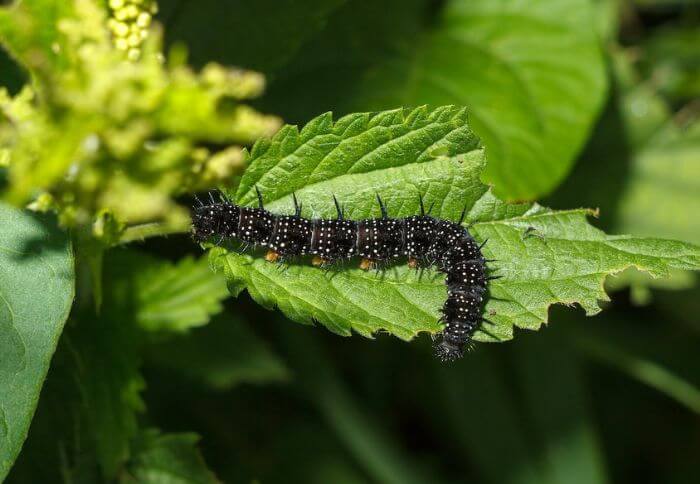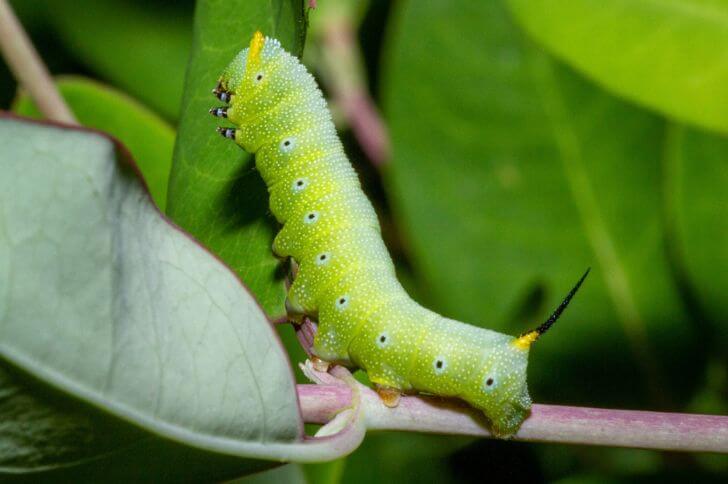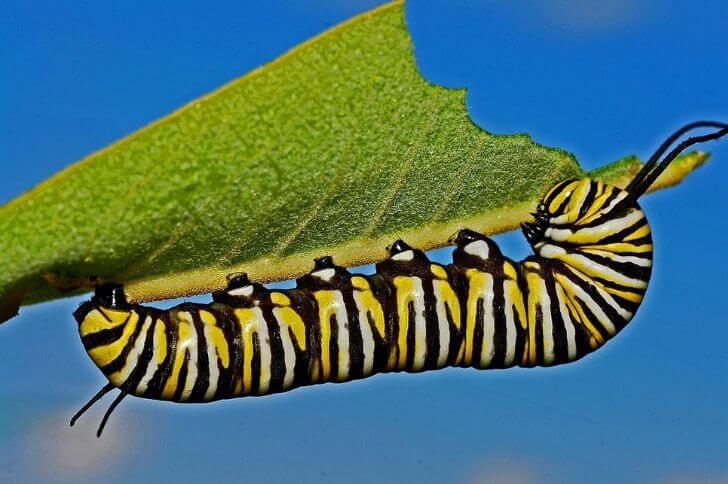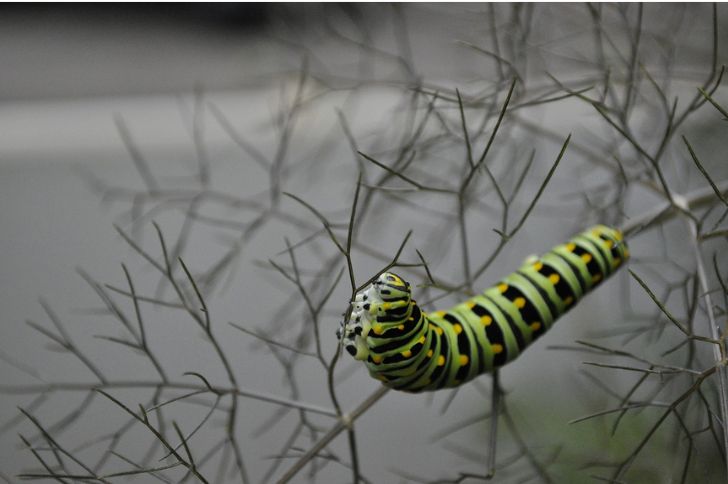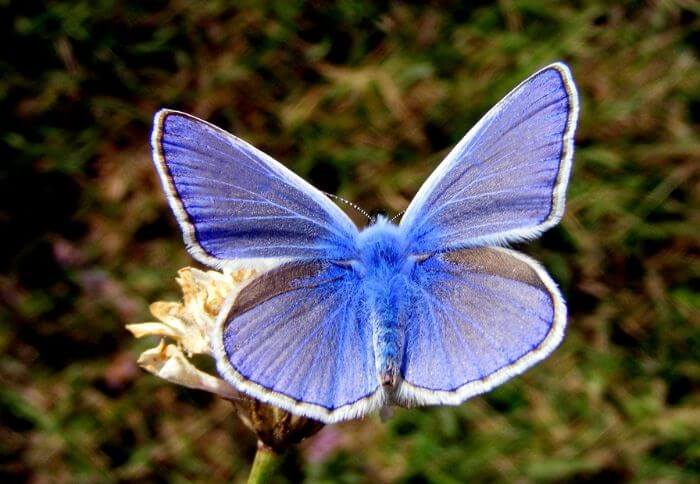19 Green Caterpillars in Florida (Identification)
Florida is not only known for its sunny beaches and vibrant wildlife, but also for its diverse array of caterpillars. These fascinating creatures, with their mesmerizing patterns and hues, play a crucial role in the state’s delicate ecosystem.
Among the many species that grace Florida’s lush landscapes, green caterpillars stand out as some of the most captivating. With their striking shades of emerald and lime, these leaf-munching insects are a sight to behold.
In this article, we will explore the different types of green caterpillars found in Florida and delve into their intriguing characteristics and behaviors. Whether you’re an avid nature enthusiast or simply curious about these colorful crawlers, join us on a journey through Florida’s verdant world of caterpillars.
List of Green Caterpillars in Florida
1. Io Moth Caterpillar
The Io Moth Caterpillar, with its bright green body and striking patterns, is a fascinating creature found in various regions of Florida. Despite its small size, this caterpillar possesses a unique defense mechanism that sets it apart from other species.
When threatened, it retracts its head into its body and extends two pairs of eye-spots on the front and back ends to give off an illusion of being much larger and fiercer than it actually is.
Not only does this visual trickery deter potential predators, but it also startles them enough to create a momentary distraction, giving the caterpillar enough time to escape to safety.
Unlike many other caterpillars that are herbivorous or consume specific plant species, these leaf-munching creatures are known for their diverse palate.
They have been observed feasting on leaves from a wide range of plants including oak trees, cherry trees, elm trees, sycamore trees, and even herbs like dandelions. This adaptability enables them to survive in various environments and makes them highly adaptable insects.
2. Tomato Hornworm
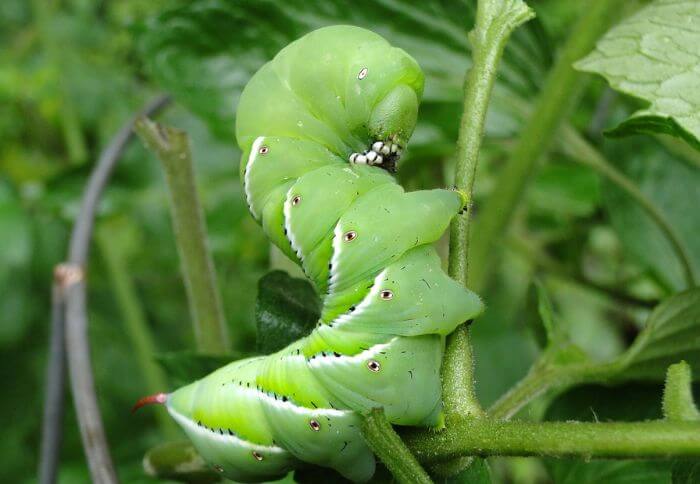
In the lush gardens of Florida, a voracious and mysterious creature lurks amidst the foliage: the tomato hornworm.
With its vibrant green color and impressive size, this caterpillar strikes fear into the hearts of many gardeners. But beyond its intimidating appearance lies an intriguing tale of ecological balance and adaptability.
During its early stages of life, the tomato hornworm may seem harmless as it feeds on leaves and stems. However, as it grows to around three inches long, it becomes a ravenous eater capable of devouring entire plants in a matter of days.
Yet, paradoxically, this creature is also a magnet for beneficial insects. The adult form of a parasitic wasp called Braconid seeks out these caterpillars as hosts for their eggs. Upon hatching inside the helpless hornworm, these tiny wasps slowly consume their host from within until they emerge victorious.
The survival strategies employed by both the tomato hornworm and its natural predators are simply awe-inspiring.
While gardeners may initially cringe at the sight of this formidable caterpillar nibbling away at their beloved crops, viewing them through an ecological lens reveals intricate relationships within nature’s web that ensure balance and harmony in our gardens.
3. Long-Tailed Skipper Caterpillar
The long-tailed skipper caterpillar is a remarkable creature that can be found in the lush landscapes of Florida.
This caterpillar is known for its vibrant green color, making it almost blend seamlessly with its surroundings. As it moves effortlessly through the foliage, one cannot help but marvel at its agility and grace.
What sets the long-tailed skipper caterpillar apart from other caterpillars is its incredible ability to camouflage itself when threatened.
When disturbed, it rolls up into a tight ball and remains motionless until the danger passes. This unique defense mechanism allows it to avoid predators and continue on with its daily activities undisturbed.
Another fascinating aspect of these caterpillars is their diet. Unlike many other species, they feed primarily on legumes such as beans and peas. This specialized diet helps them acquire specific nutrients needed for their growth and development.
4. Ceraunus Blue Caterpillar
The stunning Ceraunus Blue Caterpillar is a sight to behold in the lush landscapes of Florida. With its vibrant green color and intricate patterns, it effortlessly blends into its surroundings, making spotting one a true treasure.
But there’s more to this tiny creature than meets the eye. Did you know that the ceraunus blue caterpillar has a symbiotic relationship with ants? These caterpillars excrete a sugary substance called honeydew, which acts as a delicious treat for ants.
In return, the ants provide protection for the caterpillar against predators, creating an extraordinary partnership between two seemingly unrelated species.
In addition to their fascinating interactions with ants, Ceraunus Blue Caterpillars also undergo an incredible transformation from caterpillar to butterfly. Like other butterflies, these caterpillars go through several molts before transforming into chrysalides and eventually emerging as beautiful winged creatures.
This remarkable metamorphosis serves as a reminder of nature’s endless wonders and showcases the resilience and adaptability of these delicate insects.
5. Florida Tiger Swallowtail Caterpillar
Tiger swallowtails are found all over the US including Florida. This caterpillar goes through a dramatic transformation, starting off as a small green creature with black stripes, and eventually morphing into a beautiful butterfly.
What sets this species apart from other caterpillars is its ability to blend in with its surroundings and camouflage itself against potential predators.
As the caterpillar grows, it goes through several molting stages where it sheds its skin to accommodate its growing body. During these stages, its vibrant green color becomes even more intense, making it almost indistinguishable from the leaves on which it feeds.
This camouflage technique is crucial for their survival as they avoid being spotted by hungry birds or other predators lurking nearby.
Once fully grown, this green caterpillar in Florida forms a chrysalis where it undergoes an incredible metamorphosis. Inside the protective casing, its body breaks down into liquid form before reassembling into a magnificent butterfly with striking yellow wings adorned with black stripes.
This final transformation symbolizes hope and renewal, reminding us that change can often lead to something truly beautiful.
6. Gray Hairstreak Caterpillar
The Gray Hairstreak Caterpillar is a small and unassuming creature that often goes unnoticed. However, what it lacks in size, it makes up for in adaptability and survival skills. This caterpillar species can be found all across Florida, blending seamlessly into its surroundings with its grayish-green coloring.
It is commonly found on plants such as legumes and mallow, where it feeds on the tender leaves.But what makes these green caterpillars in Florida truly fascinating is their unique defense mechanism.
When threatened, they have the incredible ability to mimic ant behavior. They contract their bodies and wave their front legs like antennas, making themselves look remarkably similar to an ant’s head.
This clever disguise helps protect the caterpillar from potential predators who may mistake it for an undesirable meal. Such adaptability showcases nature’s ingenuity and the incredible ways in which different species have evolved to survive in their environments.
Related Read: white striped green caterpillars
7. Green Florida Cloudless Sulphur Caterpillar
The vibrant colors of nature can often surprise and delight us, and one such example is the Green Florida Cloudless Sulphur Caterpillar. This tiny creature, with its striking lime green hue, can be found in various parts of Florida and is known for its fascinating life cycle.
As a caterpillar, it spends its days feasting on the leaves of plants, effectively camouflaging itself among the foliage. However, it is during its transformation into a beautiful butterfly that this caterpillar truly shines.
Unlike many other caterpillars that pupate alone or in small groups, the green Florida cloudless sulphur caterpillar has a unique habit of forming large aggregations before undergoing metamorphosis.
These gatherings can consist of hundreds or even thousands of individual caterpillars all congregating together on a single plant or tree. Scientists believe that there may be several reasons for this behavior – from increased protection against predators to more efficient resource utilization.
Another awesome aspect about this green caterpillar of Florida is their ability to change color as they grow older.
While they start out bright green, they gradually develop yellow speckles on their body as they mature. This color change not only serves as a sign of growth but also helps them blend into their surroundings when they are ready to pupate.
8. Cassius Blue Caterpillar
Also known as the tropical striped blue, the Cassius Blue Caterpillar is a fascinating sight to behold in the lush forests of Florida. Known for its green coloration, this caterpillar stands out from the crowd. Its appearance may be captivating, but there is much more to this creature than meets the eye.
One interesting aspect of this Florida green caterpillar is its feeding habits. Unlike many other caterpillars that typically feed on specific plants or foliage, this species has a broader diet.
It has been observed munching on leaves from various trees and shrubs, displaying its adaptable nature. This flexibility allows it to thrive in diverse environments and ensures a steady supply of sustenance throughout its lifecycle.
Furthermore, the Cassius Blue Caterpillar undergoes an incredible transformation during its pupal stage. Inside its chrysalis, remarkable changes take place as it prepares for its eventual emergence as a butterfly. The once vibrant green color transitions into shades of blue and gray before giving way to delicate wings that will carry it through the air with grace and beauty.
9. Barred Yellow Caterpillar
The barred yellow caterpillar is a stunning sight to behold in the lush green surroundings of Florida. With its vibrant yellow hues and distinct black stripes, it easily catches the eye as it feasts on leaves with its voracious appetite.
But beyond its striking appearance, this caterpillar also plays a crucial role in the ecosystem as an herbivore.
What sets the barred yellow caterpillar apart from other species is its unique defense mechanism. When threatened, it has the ability to release a foul-smelling odor from specialized glands located along its body.
This not only acts as a deterrent for predators but also serves as a warning sign that this little creature means business.
10. Great Southern White Caterpillar
Found among the lush foliage of Florida, the Great Southern White Caterpillar is a captivating sight for nature enthusiasts. With its vibrant green body adorned with white markings, this caterpillar captivates onlookers and leaves them in awe of its natural beauty.
What makes this species even more intriguing is its ability to camouflage itself within its environment, effortlessly blending in with the surrounding vegetation. This clever adaptation not only helps protect the caterpillar from potential predators but also showcases its remarkable survival skills.
As it transitions into adulthood, the Great Southern White Caterpillar undergoes a metamorphosis that transforms it into a stunning butterfly.
This transformation is an extraordinary process that emphasizes nature’s ability to create mesmerizing creatures. The delicate wings of the butterfly boast a pure white hue, traversed by intricate veins and bordered by subtle gray accents. They flutter through meadows and gardens, spreading joy with their graceful flight.
Observing these creatures up close reveals their dedication to protecting their offspring as well. When threatened or disturbed, adult female butterflies deploy a defense mechanism that involves flapping their wings rapidly towards any perceived danger, effectively scaring off intruders and safeguarding their young ones from potential harm.
Such characteristics make this green caterpillar in Florida an enchanting creature that embodies both beauty and intelligence – truly a remarkable addition to Florida’s diverse ecosystem.
11. Dainty Sulphur Caterpillar
The vibrant white and reddish stripes of the dainty sulphur caterpillar is enough to catch anyone’s eye. This tiny creature, despite its delicate appearance, is actually quite strong and adaptable.
Found commonly in Florida, this caterpillar feeds on various types of plants, primarily those in the pea family.
Although small in size, don’t underestimate the impact these little caterpillars have on their ecosystem.
They play an important role in pollination by visiting flowers and collecting nectar while searching for food. By doing so, they assist in fertilization and contribute to the overall health of plant populations.
12. Black Swallowtail Caterpillar
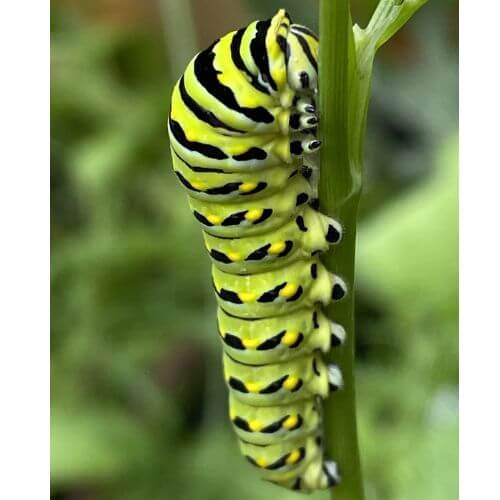
Black swallowtails are another common type of green caterpillars in Florida. Scientifically called Papilio polyxenes, it is a stunning and intriguing creature that can be found in the vibrant state of Florida.
With its striking green body punctuated by bold yellow and black stripes, this caterpillar certainly knows how to capture attention. But what makes it truly fascinating is its behavior.
Unlike other caterpillars that blend into their surroundings for protection, the black swallowtail caterpillar boldly displays its bright colors, warning potential predators of its unappetizing taste.
This strategy, known as aposematic coloration, serves as a defense mechanism against hungry birds and other animals looking for a quick snack. The caterpillar achieves this deterrent effect by incorporating toxins from the plants it eats into its body, making it distasteful or even poisonous to would-be attackers.
13. North American Luna Moth Caterpillar
The North American luna moth caterpillar, also known as Actias luna, is a fascinating creature that captivates the attention of anyone lucky enough to spot one in the wild.
Growing up to 3 inches long, these green and spiky caterpillars can be found in various regions of North America, including Florida. What sets them apart is their unique appearance and remarkable growth cycle.
These striking caterpillars have vibrant lime-green bodies with black stripes running along the length of their segmented bodies. Their most distinctive feature is a set of elongated horn-like projections at both ends, giving them an alien-like appearance.
As if this wasn’t interesting enough already, this green caterpillar in Florida undergoes a stunning transformation during its life cycle. After reaching maturity as caterpillars, they retreat into cocoons and emerge as magnificent green moths with breathtaking tails that span up to four inches.
14. Polyphemus Moth Caterpillar
The Polyphemus Moth Caterpillar is a fascinating creature that can be found in the lush landscapes of Florida.
This vibrant green caterpillar, with its bold patterns and unique shape, is a sight to behold. One of its most notable features are the large eye spots on its thorax, resembling those of the mythical Cyclops, Polyphemus.
These eye spots not only give the caterpillar an intimidating appearance but also serve as a defense mechanism against predators.
As one admires this Florida caterpillar, it is hard not to marvel at its incredible transformation from egg to adult moth. This creature undergoes a complete metamorphosis from crawling caterpillar to elegant flying beauty.
After feeding voraciously for weeks on foliage in its surroundings, it will spin itself into a silken cocoon known as a pupa. Inside this sanctuary, magical changes occur within the caterpillar’s body until it emerges as a magnificent Polyphemus Moth.
While many may underestimate these seemingly ordinary green caterpillars wandering among plants in Florida, they hold secrets and wonders waiting to unfold before our eyes. The intricate design and adaptation of their bodies offer glimpses into nature’s brilliance and remind us that even humble creatures have stories worth hearing.
15. Cabbage Looper Caterpillars
Cabbage looper caterpillars may seem like just another garden pest, but their impact is far-reaching and often underestimated. These voracious eaters can decimate entire crops of cabbage, kale, and other leafy greens in a matter of days.
The green caterpillars are masters at disguise, blending seamlessly with the foliage they feed on, making them even more difficult to detect and control.
One interesting fact about cabbage loopers is that they belong to the family of inchworms. This means that instead of moving like typical caterpillars, they have a unique looping motion where they arch their body up and then extend it forward before bringing their back end close to meet it.
This distinctive movement allows them to blend in even more with the leaves, making it harder for predators or gardeners to spot them.
16. Palamedes Swallowtail Caterpillar
As you stroll among the vibrant foliage of Florida, keep an eye out for a fascinating creature known as the Palamedes Swallowtail Caterpillar.
This caterpillar boasts a striking appearance with its black body adorned by captivating green spots. Its distinct markings make it stand out amidst its leafy habitat, drawing attention from nature enthusiasts eager to witness its incredible transformation.
One intriguing fact about the palamedes swallowtail caterpillar is its unique relationship with plants. While many caterpillars rely on a specific plant species for survival, this particular species feeds on a variety of trees including sweetbay and red bay.
The ability to adapt gives it an advantage in finding food sources even if their preferred options are scarce. This flexibility showcases their remarkable resilience and adaptability in the face of changing environments.
Observing the behavior of these caterpillars can be highly rewarding, as they display intriguing defense mechanisms against predators. When threatened, they extend bright orange osmeteria organs from behind their heads.
These organ-like structures release foul-smelling chemicals that deter potential attackers, ensuring their survival in the wild. Such adaptations serve as reminders that nature constantly finds ways to protect itself and sustain life even in high-pressure circumstances.
17. Cecropia Moth Caterpillar
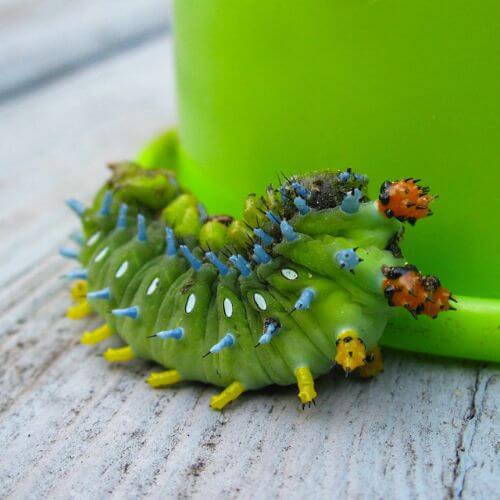
One of the most remarkable caterpillars you may encounter in Florida is the Cecropia Moth Caterpillar. With its vibrant green body and bold patterns, this caterpillar is truly a sight to behold. But what makes it even more fascinating is its size – reaching up to 4 inches in length!
This caterpillar stands out not only for its striking appearance but also for its voracious appetite. It feeds on a variety of trees including maple, cherry, and birch, stripping them bare as it grows.
As the Cecropia Moth Caterpillar continues to munch away on leaves, it undergoes several molting stages, shedding its exoskeleton multiple times.
During these molts, you might notice small spikes or protrusions along its back which provide added protection from predators. Moreover, despite being covered in these intricate spikes, the caterpillar remains harmless and purely herbivorous.
Once fully grown and ready to enter the final stage of metamorphosis, the Cecropia Moth Caterpillar seeks out a safe location to pupate. It spins a silky cocoon attached to branches or other surfaces using silk produced by specialized glands within its body.
Inside this cocoon lies an amazing transformation waiting to occur – after a few weeks or months (depending on temperature), an adult moth emerges with large wings that span up to six inches! The male moth showcases stunning reddish-orange coloration while females display a more muted brown hue.
18. Tobacco Hornworm
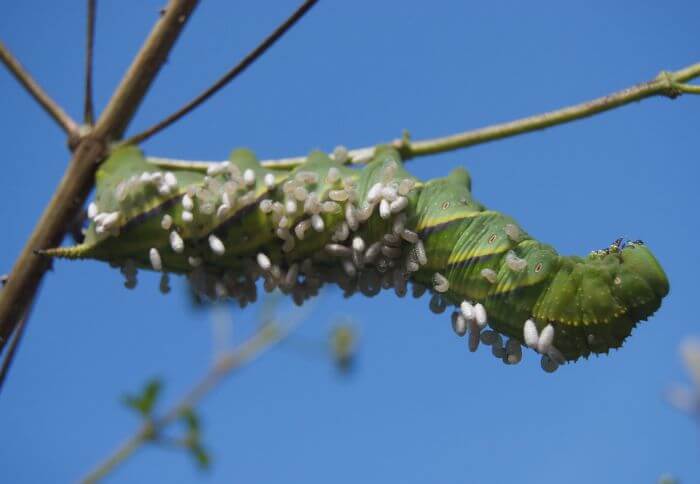
One fascinating species of caterpillar commonly found in Florida is the Tobacco Hornworm (Manduca sexta). This stunning creature can grow up to 4 inches long and has a vibrant green body adorned with black and white markings.
Despite their size and appearance, these caterpillars are surprisingly easy to overlook due to their exceptional camouflage abilities. They have evolved to blend perfectly with the foliage, making them almost invisible as they munch on leaves.
But what makes the Tobacco Hornworm truly intriguing is its diet. As their name suggests, these caterpillars have a particular affinity for feeding on tobacco plants. Their voracious appetite allows them to devour entire leaves within hours.
However, while this may seem like an annoyance to farmers or gardeners, it actually serves an important ecological purpose. By consuming large quantities of tobacco plants, the Tobacco Hornworm helps control the growth of these invasive species in certain areas.
Another aspect that sets the Tobacco Hornworm apart from other caterpillars is its unique adaptation to defend against predators. Along both sides of its abdomen are several pairs of blue spots resembling eyespots. T
hese false eyes serve as a clever defense mechanism by tricking predators into attacking the wrong end of the caterpillar – its rear rather than its head – enabling it more chances for escape.
19. Spiny Oak Slug Caterpillar
One of Florida’s most intriguing and visually striking caterpillars is the Spiny Oak Slug Caterpillar. With its bright green coloration and numerous spines, it is hard to miss this distinctive creature as it makes its way across oak tree branches.
While its appearance may be fascinating, it’s important to handle this caterpillar with caution, as those spines can deliver a painful sting.
The Spiny Oak Slug Caterpillar belongs to the family of Limacodidae, which are known for their slug-like bodies covered in bristles or spines.
These spines serve as a defense mechanism against predators – when threatened, the caterpillar will retract its body into a flattened shape and use the sharp spines to deter would-be attackers. This adaptation not only provides protection but also acts as camouflage among the oak leaves due to its similar shape and color.
While other caterpillars rely on cryptic colors or hidden behaviors to evade predators, the Spiny Oak Slug Caterpillar boldly displays its defenses. Its vibrant green hue is not meant to blend in but rather warn potential threats about the consequences of getting too close.
It’s remarkable how nature has equipped this caterpillar with such efficient mechanisms for self-preservation – reminding us that survival often comes down to standing out rather than blending in.
Final Thoughts:
In conclusion, Florida is home to a variety of green caterpillars that play important roles in the ecosystem. From the familiar tomato hornworm to the stunning spicebush swallowtail, these caterpillars can be found in gardens, forests, and natural areas across the state.
While some may cause damage to crops or ornamental plants, others are crucial pollinators or serve as food sources for birds and other wildlife.
Understanding the different types of green caterpillars in Florida not only enhances our appreciation for nature’s diversity but also helps us make informed decisions about pest management and conservation efforts. So let’s continue to explore and protect the fascinating world of green caterpillars in our Sunshine State.
Source:
https://en.wikipedia.org/wiki/Antheraea_polyphemus
Passionate animal photographer with an unwavering love for capturing the essence and beauty of our furry friends.
With over five years of experience in the field, I have developed a unique ability to connect with animals on a deeper level, allowing me to create stunning and captivating images that truly reflect their personality.
Let’s collaborate to capture unforgettable moments that celebrate the unique bond between humans and animals!
